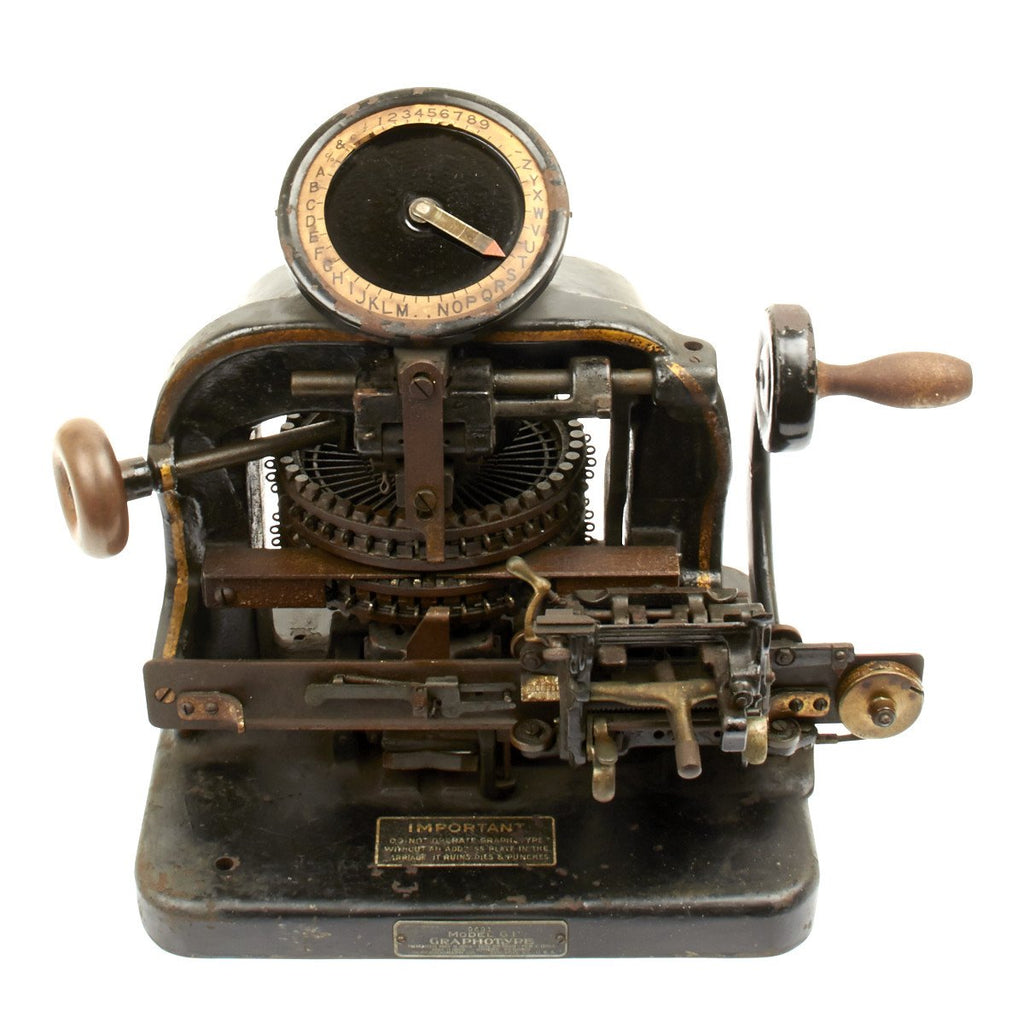Item Description
Original Item: Only One Available. This is a fully functional 1909 patented Graphotype Model G1 6100 Series Metal Dog Tag Machine. It was made by the Addressograph Company of Chicago, Ill., has patent dates which range from May 9, 1899 through May 11, 1909 with serial number 9691.
This visual marvel of a well made instrument likely made dog tags during WWI and WWII and can be used to make additional dog tags or other addressing plates or used for period display. The Graphotype machine measures 16 x 19 x 29 and weighs 103 pounds.
The data plate reads:
9691
MODEL G1
GRAPHOYPE
PATENTED MAY 9TH, 1899 - NOVG. 28, 1899 - FEB. 2. 1904
MAY 11, 1909 - OTHERS PENDING
ADRESSOGRAPH CO. CHICAGO ILL, U.S.A.
Operation is quite simple: one turns the dial to select the letter or number then pulls the handle which impresses the character into a blank plate (tag). These machines were used by the U.S. Military, private corporations and civilian organizations from the turn of the century to the late 1940’s.
History of Dog Tags in the US Military:
December 20, 1906
War Department General Order No. 204 states "An aluminum identification tag, the size of a silver half dollar and of suitable thickness, stamped with the name, rank, company, regiment, or corps of the wearer, will be worn by each officer and enlisted man of the Army whenever the field kit is worn, the tag to be suspended from the neck, underneath the clothing, by a cord or thong passed through a small hole in the tab. It is prescribed as a part of the uniform and when not worn as directed herein will be habitually kept in the possession of the owner. The tag will be issued by the Quartermaster's Department gratuitously to enlisted men and at cost price to officers ..." This is the first time each soldier get his own government-provided identification tag.
1913
Army Regulations requires the tag to be worn at all times.
July 06, 1916
Government starts issuing two tags for each soldier. Now they have a pair, one stays with the body and the other goes to the person in charge of the burial for record keeping purposes.
May 12, 1917
General Order No. 294 sent out by Secretary of the Navy Josephus Daniels requires tags to be issued to Navy personnel.
February 12, 1918
Official introduction of the Army Service Number. There are just too many John Smiths to keep straight. Service Number 1 was assigned to enlisted man Arthur B. Crean of Chicago in the course of his fifth enlistment period.
1936
William Randolph Hearst tried to undermine support of President Roosevelt's Social Security plan and reelection by alleging that all citizens would have to wear a metal tag with their Social Security Number (SSN) on it and also have to fill out questionnaires asking personal information. This story was not true, but the idea had come up before.
When trying to figure out how to issue a SSN to people, one idea was the use of SSN Nameplates. Commissioner Altmeyer didn't like the idea and vetoed it as soon as it came across his desk. The Addressograph Co. wanted to get more business from the government and went as far as making a sample tag for Commissioner Altmeyer. This is the one and only SSN tag ever made. It currently resides in Baltimore at the Social Security Administration Headquarters museum.
October 1938
Military starts developing a new identification tag.
1940
The M-1940 Identification Tag (Stock Number 74-T-60) is issued to troops.
1943
Necklace and Extension sets (Stock Number 74-N-300) are issued by the military. The ball chain has finally become the standard necklace.
- This product is available for international shipping.
- Eligible for all payments - Visa, Mastercard, Discover, AMEX, Paypal & Sezzle















